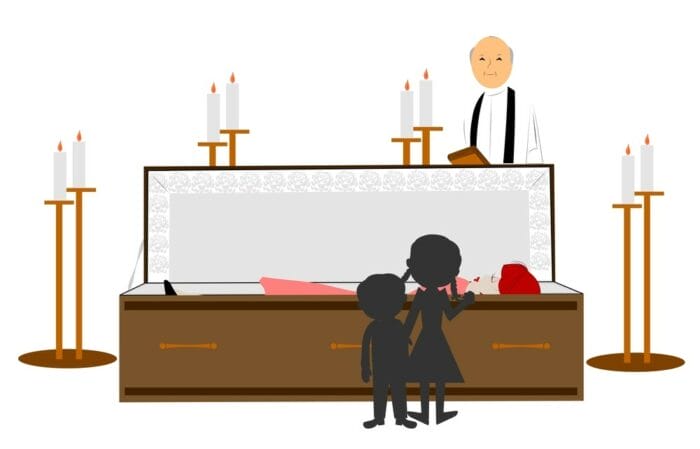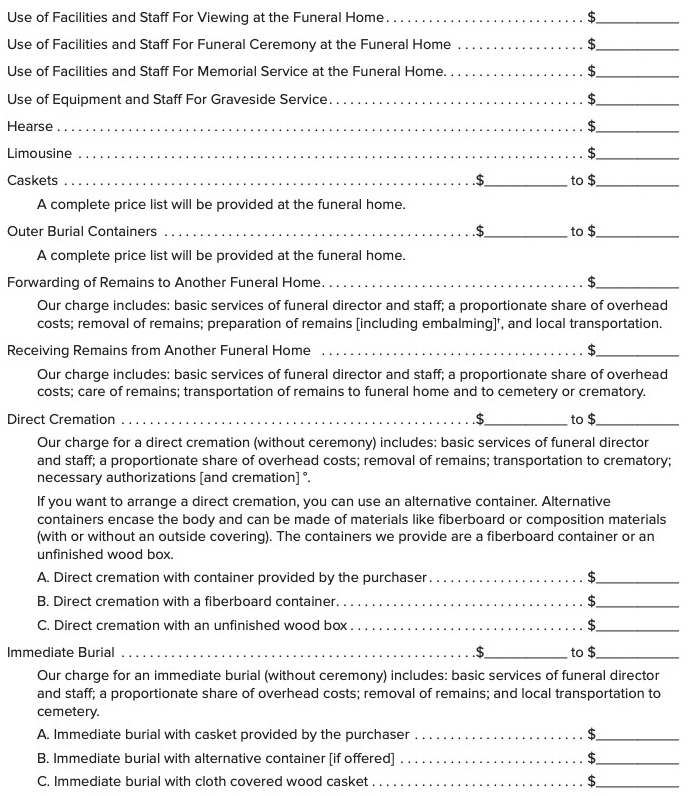It is NOT cheap to die these days.
Average funeral costs in the U.S. are currently over $7,567*, according to the National Funeral Directors Association (NFDA). And if you include the cost of the burial plot and associated burial costs, the total cost of a funeral tops $10,000.
Funeral planning is not a fun task, but more and more Americans are doing so so that they can give their loved ones the most dignified final disposition without having to take finances into account.
The cost of a traditional funeral (i.e., a memorial service followed by burial of the body) can be broken down into eight major expenses, one of which is the embalming of the body.
In the following three sections, we’ll answer each of these questions in detail.
- What is embalming?
- Should you purchase embalming?
- If yes, how much does embalming cost?
- Ways to save on embalming costs
Let’s dive in
Choose kindness.
You never know what battles people may be fighting.
What Is Embalming?
Embalming is a chemical process that temporarily preserves a dead body. This is typically done so that the body is presentable for viewing at the memorial service.
The funeral home you choose will be the one to provide embalming services.

The Embalming Process
The embalming process and the preparation of the body can be broken down into three steps:
- Preparing a Body for Embalming: The initial step involves preparing and cleaning the corpse (there’s more here, but we’ll spare you the immaterial details)
- The Actual Embalming: Step two is the crucial step, during which the embalmer injects embalming fluid (a mixture of formaldehyde, methanol, and other solvents) into the body’s arteries. This fluid preserves the body’s tissues and prevents decomposition
- Cosmetic Preparation: The third step involves cosmetic work, such as hair styling and applying makeup, as desired by the family
Note: If the body has suffered an injury, there are also restorative techniques, using waxes and other reconstructive materials, that may be able to return your loved one to the condition in which you remember them.
Embalming Timeline
A body presents little threat to public health on the first day following the death. However, after 24 hours, the body will need some level of embalming.
A mortuary will be able to preserve the body for approximately a week.
Regardless of the embalming, decomposition will begin after one week.
(Your local funeral director will be the best person to provide you with more specific guidance on timing.)

Should You Purchase Embalming Services?
While some funeral homes require embalming a body after death, state laws do not require it.
The main exception to this is if the body must be transported across state lines, from the place of death to the location of the final arrangements. Most states require some form of preservation so that the corpse is presentable for transport.
Therefore, in most cases, your decision to purchase embalming hinges on your chosen type of final arrangement.
You DO Need Embalming If…
…you plan to go with traditional American funeral arrangements (funeral service, followed by interment and a short burial service).
This is especially true if you plan to hold an open-casket viewing as part of the funeral arrangements. Can you have an open casket without embalming? Yes, but keep in mind that if you decide against embalming the body within 24-48 hours of death, the effect can be quite noticeable on your loved one’s appearance.
You Likely Do NOT Need Embalming If…
…you choose direct cremation or direct burial.
Direct cremation is cremation shortly after death and without a memorial service.
Similarly, with direct burial, the body is buried soon after death, usually in a simple container. There is no viewing or service; however, a memorial service may be held at the graveside or after burial.
However, note this may be logistically difficult. If they don’t want to embalm dead body, grieving family members will need to agree that direct burial or cremation is the right option within 24 hours of death.
The body will begin to decompose and will not be presentable for viewing.
If your decision is likely to take longer than a day, it may be best to have the body embalmed and keep all of your options open.
Choose kindness.
You never know what battles people may be fighting.
How Much Does Embalming Cost?
Body embalming is one of many expenses you will be confronted with when you begin the planning process. But, how much does it cost to embalm a body?
According to the National Funeral Directors Association, the national average cost to embalm a body is currently $750.
This cost of embalming a body will vary based on both the funeral providers’ location and funeral planning decisions you make, such as having an open-casket service. In most cases, the cost for embalming will be somewhere in the $400 to $1,000 range.
Keep in mind that some funeral homes include the process within their standard funeral package, so the price of embalming may already be accounted for in the cost of your funeral package.
Determining Your Local Cost Of Embalming
Whenever you meet with a funeral home, the funeral director is required by law to give you a “general price list” before discussing any aspects of your funeral arrangements.
This law is called the “Funeral Rule,” and all funeral providers should be familiar with it. It was put into place by the Federal Trade Commission (FTC), whose goal was to help grieving family members make informed choices and prevent unscrupulous funeral providers from preying on vulnerable funeral consumers. (Should you need them, another consumer protection group is the Funeral Consumers Alliance.)
The list should look somewhat like the below sample GPL.
Sample Funeral Home Price List


How To Save Money On Embalming Costs
Now that we’ve learned how much is embalming set to lower your bank account balance, let’s talk saving money!
But first, let’s get one thing straight: does a body have to be embalmed? The answer is no. The key is to preserve the body, which can be done in more than one way.
There are two paths to save money on embalming costs.
1. Alternative, Affordable Preservation
Whether you use embalming or not, the goal is to preserve the body.
One non-embalming option would be to preserve the body via dry ice, which involves placing large chunks of dry ice into an airtight container with the deceased’s body until burial. This method is less expensive than traditional embalming, but it’s not a viable option for viewing.
Refrigeration (at the funeral home) is one other preparation method for the body.
It involves keeping the body in a room-temperature (not frozen) environment and using other preservation techniques. This is generally less expensive than embalming, but you will not be able to view the deceased at this stage either.
2. Avoid Embalming Altogether
The easiest and most affordable option is to avoid embalming altogether.
The major drawback of this is that it limits your options to direct cremation or burial.
The major upside is that the cost savings can be tremendous, not only from the $800 you saved on embalming.
If you choose cremation (and do not want to bury the ashes), your total bill could be as low as $1,500 (average direct cremation cost in the U.S.).
And while immediate burial won’t be nearly as cheap, given the cost of the cemetery plot and burial costs, you will still save on three major funeral expenses: (1) the cost of the service, (2) the cost of the casket, and (3) the cost of the embalming process.
These three costs combined easily exceed $5,000, so the savings on the burial side aren’t too shabby either.
Frequently Asked Questions About Embalming
What Is The Average Cost Of Embalming?
Embalming averages around $750-$800 and rarely costs more than $1,000. While embalming is included in most funeral home packages, it isn’t always required. The need for embalming depends on whether or not the body is buried or cremated and how quickly the service takes place after the deceased’s passing.
Can You View An Unembalmed Body?
If it has been longer than 48 hours post-death, the body will not be suitable for viewing. If you are unsure about whether to have a viewing, you should purchase embalming and other preparation services to be safe.
How soon does a body need to be embalmed?
Remains that have not been embalmed will start decomposing within 24 hours of death and will speed up significantly 48 hours after death.
Choose kindness.
You never know what battles people may be fighting.
Conclusion
What is embalming a body and when is it done?
Embalming is one of many final arrangement expenses you will have to weigh.
If you’re on a budget, it may be best to skip out on an open-casket viewing. This way, your embalming costs will be lower, and you can use these funds for items that often carry high emotional weight with family members, such as the quality of the memorial service.
If you can, try visiting multiple funeral homes. Not only will you have a better sense of what market prices are in your area, but you also may relate better to one funeral director over the other. For better or worse, your ease and comfort in working with your funeral director can be a huge emotional boost or drag while you are going through some of the toughest days of your life.
We hope you find this resource on embalming costs useful. If you have any questions, don’t hesitate to leave a comment or send us an email at [email protected].
Warm Regards,
The GetSure Team


